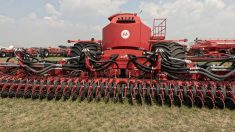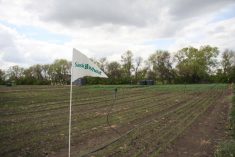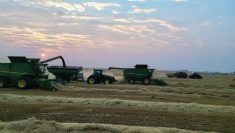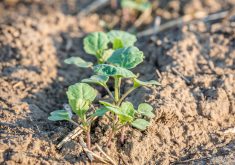If uniformity of stand establishment is a key element to optimizing crop yield, is one seeding system better than another? Should you run out and buy something new?
According to Jason Casselman, an agronomy specialist with the Canola Council of Canada, farmers can make gains in the uniformity of their canola stands just by paying attention to the details of how they operate the seeding equipment already on the farm.
Having said that, some of the newer seeding technology on the market is designed to remove variability associated with getting a crop seeded and growing. The message there being, if you are looking for a new seeding system, there are definitely some options.
Read Also

Lightning gives and takes in Prairie fields
Lightning in fields can be a source of nitrogen but at times can result in crop damage which, at a glance, resembles a very localized disease outbreak, plant pathologist Ieuan Evans writes.
Several years of applied research in southern Alberta has looked at the potential of using vacuum planters not just for row crops but for seeding grain, oilseeds and pulse crops as well. And Saskatchewan seed drill manufacturer SeedMaster has designed its seeding equipment not only around the uniformity of seed placement, but in the gentle handling of seed as well.
If seeds aren’t banged up in the air distribution system, there is a good chance more will germinate, which should contribute to reduced seed cost and increased production and profitability.
Farming Smarter research
The southern Alberta applied research association Farming Smarter has found that a vacuum planter can be quite effective in seeding a wide range of field crops including canola, durum and pulse crops, such as chickpeas, faba beans and peas.
The organization’s four-year study tested three seeding systems: an air drill at 12-inch row spacing, a precision planter at 12-inch row spacing and a precision planter at 20-inch row spacing. Crops were seeded at five seeding rates of 20, 40, 60, 80, and 160 seeds per square metre.

Gurbir Dhillon, a research scientist with Farming Smarter, says although there was variability over the four years of both irrigated and dryland research trials, overall yields of the various crops seeded with the Monosem precision planter were as good as, if not better than, the same crops seeded with an air seeding system.
Dhillon says, generally, under irrigation or growing seasons with improved moisture conditions, all crops had improved emergence and uniformity with the precision planter compared with those seeded with an air seeder. And in many cases yields were improved.
“The precision planters generally provided a better performance, especially in terms of crop emergence and plant stand establishment,” states Dhillon in a project report. “The seedling emergence improved for the majority of the crops including canola, pulse crops, durum and hemp.”
Crop stands seeded with precision planters also showed more spatial uniformity and even crop staging, which can promote weed suppression and more efficient application of fungicides and plant growth regulators.
“These improvements in crop stand establishment led to higher yield for certain crops, especially canola and chickpeas. However, the improvement in yield varied among different site years and was favoured by conditions favouring higher productivity such as irrigation or high precipitation. Nevertheless, the performance of precision planters was at least comparable to the conventional air drill in low-precipitation conditions for all crops.”
Dhillon says more research is needed but this project suggests precision planters can be used to successfully seed narrow-row grain, oilseeds and pulse crops.
SeedMaster technology
Developing seeding technology to improve seed placement and ultimately create uniform plant stands has been the focus of SeedMaster engineers since day one, says Tim Criddle, global sales director for SeedMaster Manufacturing.
“That is what company founder Norbert Beaujot set out to achieve,” says Criddle.
“As a farmer himself, he was looking at how to achieve more uniform stand establishment. He was frustrated by the fact that seeding systems of the day produced plant stands with a great deal of variability across the field.”
Beaujot set out to design a zero-till seeding system with uniform placement of seed that would produce uniform crop emergence, leading to improved nutrient uptake, more efficient use of in-crop herbicides and pesticides and, ultimately, improved yields.

“The company mantra from the beginning has been if you don’t get the crop seeded properly to begin with, the rest of the year you are always playing catch-up,” says Criddle. “The crop will struggle to achieve its maximum potential.”
The first feature developed by SeedMaster is the dual knife opener that places seed on one firm packed level and fertilizer on another.
“It is very precise seed placement with the seed separated vertically and horizontally — above and to the side — of the fertilizer,” says Criddle. “The crop safely germinates but as seedling roots develop they don’t have to reach very far to find the nutrients.”
The second main feature of SeedMaster technology involves seed distribution in the seed row. It’s called the UltraPro II metering system.
“It has planter-like precision, but it is not a planter,” says Criddle. “It has near-planter-like singulation of seed. If you take a close look at the seed row, you are going to find very uniform placement of seed — seed then a gap, seed then a gap, seed then a gap — all very evenly spaced in the seed row. We have eliminated all of that clumping of seeds or huge spaces between seeds.”
Criddle says it is excellent technology for seeding any crop “but with canola this technology shines in three key aspects of seeding canola.”
First, depth control and seed placement is very accurate. Second, the UltraPro II meter system provides near-singulation of seed placement in the seed row.
“And the third aspect, which is acutely important from a cost management point of view, is we have 100 per cent eliminated the tower seed distribution system,” he says. The seed is not blasted into a tower and then through a distribution manifold, which can cause seed damage and seed mortality.

Gentle handling
“We wanted to develop a gentle handling system that would eliminate seed mortality to statistically be as close to zero as possible,” says Criddle. The UltraPro II system involves a seed meter for each run across the width of the drill. And each meter has its own dedicated seed line, a hose, which carries seed from the meter down to the seed knife and drops the seed gently into the ground. There are separate lines for seed and fertilizer.
“Looking at the economics of today’s canola production, farmers are targeting a recommended plant count of five to eight plants per square foot,” says Criddle. “But to achieve that plant count with a conventional air seeding distribution system, they have to factor in a mortality rate of perhaps 30 or 40 per cent. That’s 30 to 40 per cent of the seed they know won’t germinate.”
Criddle says with the UltraPro II system that loss has been eliminated.
“We have farmers using the system who now base their seeding rate on zero mortality, or perhaps five per cent mortality at the most,” he says. He points out if canola seed costs $15 per pound and farmers are targeting a five pound per acre seeding rate, the UltraPro II metering system allows them to eliminate 40 per cent seed waste.
Another more recent SeedMaster design feature is the Ultra SR (single rank) air drill, which features a 60-foot single rank toolbar with openers set on 15-inch spacing. It has a total 735-bushel capacity.
Viewed as a simpler seeding system with fewer moving parts, the 60-foot Ultra SR toolbar has 48 openers versus “a more conventional” seeding tool with 10-inch spacing and three or four ranks carrying 72 openers. The Ultra SR drill has rotating spoked wheels between the openers that move crop residue to the side so the openers don’t get hung up on trash.
Criddle says while some farmers are concerned that the row spacing is too wide for economical crop production, SeedMaster field research and on-farm research trials carried out by farm customers show the single rank toolbar with 15-inch row spacing resulted in higher yields.
One canola yield trial comparing a drill with 12-inch row spacing with the Ultra SR drill showed a five bushel per acre increase in canola yields on 15-inch spacing.
Another farmer producing durum measured about a six-bushel-per-acre yield increase with the 15-inch row spacing compared with a crop seeded with 12-inch row spacing (77 bushels per acre versus 71.5 bushels per acre). And a lentil crop yielded 43.5 bushels per acre on 15-inch spacing compared with 40.1 bushels per acre on 12-inch spacing.
Criddle says SeedMaster design features are all geared to produce a very uniform, high-yielding crop to help optimize farm profitability.
















